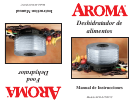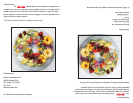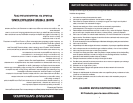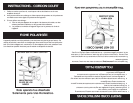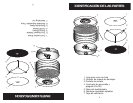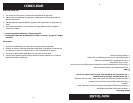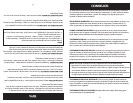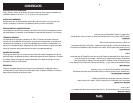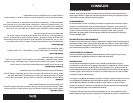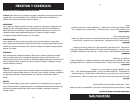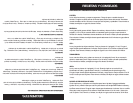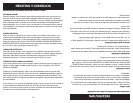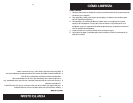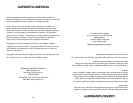
RECIPES/TIPS
10
10
PREPARING AND DEHYDRATING JERKY AND LEATHERS:
MEAT JERKY:
Use lean meat. Cut off any visible fat as it can make jerky turn rancid. Cut meat into
long narrow strips. Marinate meat 1 to 24 hours (depending on your preference) in the
refrigerator and drain. Place roll-up sheet on bottom tray and place meat on trays.
Dehydrate for about 10 to 17 hours. Beef or fish do not need to be cooked prior to
dehydrating. However, it is recommended that turkey or chicken be cooked prior to
dehydrating.
FRUIT LEATHERS:
Choose fresh, ripe fruit. Wash and remove stems and pits. Peel the fruit and cut out any
bruised sections. Puree in a blender until very smooth. Sweeten to taste by adding 1
tbsp. of honey, fruit juice concentrate or corn syrup per quart of puree. DO NOT USE
SUGAR AS IT WILL CRYSTALIZE AS IT DRIES. Spread on fruit leather sheet and
dehydrate for 8 to 10 hours or until leathery.
VEGETABLE LEATHERS:
Wash, peel, steam, chop and puree vegetables until smooth. Water may be needed to
make blending easier. Add spices to taste before drying. Spread on fruit leather sheet
and dehydrate for 8 to 10 hours or until leathery.
HELPFUL HINTS FOR LEATHERS:
To prevent leather from sticking, coat the fruit leather sheet with any vegetable spray or
oil. You may also line it with plastic wrap. DO NOT USE PAPER OR FOIL.
If you experience uneven drying, tilt and shake trays until puree is evenly distributed.
If leathers seem too brittle, you have probably over dried or you may need to adjust your
vent settings. (Please remember the settings are always suggested. Adjust them to suit
your needs.)
If your leathers look dark, you may add some lemon juice or vitamin C to the puree.
Adjust the consistency of your puree with fruit juices or other thicker purees.
If the leather spoils, the leather was not dry before storing or was exposed to moisture
during storage.
RECETAS Y CONSEJOS
PREPARACIÓN Y DESHIDRATACIÓN DE CECINA Y PIELES:
CECINA DE CARNE:
Use carne magra. Corte cualquier grasa visible porque puede hacer que la cecina se
enrancie. Corte la carne en tiras largas y delgadas. Marine la carne de 1 a 24 horas
(dependiendo de su preferencia) en el refrigerador y escurra. Coloque la hoja enrollable
sobre la bandeja inferior y coloque la carne sobre las bandejas. Deshidrate durante
aproximadamente 10 a 17 horas. La res o el pescado no se necesitan cocinar antes de
la deshidratación. Sin embargo, se recomienda que el pavo o el pollo se cocinen antes
de la deshidratación.
CUEROS DE FRUTA:
Elija fruta fresca y madura. Lave y retire los tallos y las semillas. Pele la fruta y corte
cualquier parte magullada. Haga un puré en la licuadora hasta que esté muy suave.
Endulce para darle sabor con una cucharadita de miel, concentrado de jugo de fruta o
jarabe de maíz por cuarto de puré. NO UTILICE AZÚCAR PORQUE SE CRISTALIZA
CONFORME SE SECA. Esparza sobre la hoja para cuero de fruta y deshidrate durante
8 a 10 horas o hasta que tenga la textura de cuero.
CUEROS DE VEGETALES:
Lave, pele, ponga al vapor, corte y haga puré los vegetales hasta que estén suaves.
Quizá necesite agua para hacer más fácil su mezcla en la licuadora. Agregue especias
para darle sabor antes del secado. Esparza sobre la hoja para cuero de fruta y
deshidrate durante 8 a 10 horas o hasta que tenga la textura de cuero.
CONSEJOS ÚTILES PARA LOS CUEROS:
Con el fin de prevenir que el cuero se pegue, cubra la hoja para cueros de fruta con un
aerosol o aceite vegetal. También puede colocarle un forro de plástico. NO UTILICE
PAPEL NI ALUMINIO.
Si obtiene un secado disparejo, ladee y sacuda las bandejas hasta que el puré esté
distribuido de manera uniforme. Si los cueros se ven demasiado quebradizos, quizá los
haya secado de más o tal vez necesite ajustar su configuración de la ventilación. (Por
favor recuerde que las configuraciones siempre se sugieren. Ajústelas para adecuarlas a
sus necesidades).
Si sus cueros se ven oscuros, quizá pueda agregar un poco de jugo de limón o vitamina
C al puré. Ajuste la consistencia de su puré con jugos de fruta u otros purés más
gruesos. Si el cuero se echa a perder, el cuero no estaba seco antes de almacenarlo o
se expuso a la humedad durante su almacenamiento.



